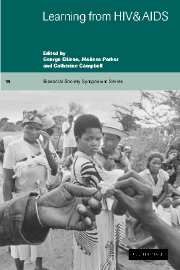Book contents
- Frontmatter
- Contents
- List of contributors
- Foreword by D. Clarke-Patel
- 1 Introduction. Learning from HIV and AIDS: from multidisciplinary to interdisciplinarity
- 2 HIV and the evolution of infectious diseases
- 3 The epidemiology of HIV/AIDS: contributions to infectious disease epidemiology
- 4 The influence of HIV/AIDS on demography and demographic research
- 5 What have clinicians learnt from working with HIV/AIDS? A medical perspective from London
- 6 How has the HIV/AIDS pandemic contributed to our understanding of behaviour change and health promotion?
- 7 Anthropological reflections on HIV prevention strategies: the case for targeting London's backrooms
- 8 An absence of anthropology: critical reflections on anthropology and AIDS policy and practice in Africa
- 9 A disaster with no name: the HIV/AIDS pandemic and the limits of governance
- 10 Postscript: reflections on HIV/AIDS and history
- Country index
- Subject index
- References
2 - HIV and the evolution of infectious diseases
Published online by Cambridge University Press: 14 January 2010
- Frontmatter
- Contents
- List of contributors
- Foreword by D. Clarke-Patel
- 1 Introduction. Learning from HIV and AIDS: from multidisciplinary to interdisciplinarity
- 2 HIV and the evolution of infectious diseases
- 3 The epidemiology of HIV/AIDS: contributions to infectious disease epidemiology
- 4 The influence of HIV/AIDS on demography and demographic research
- 5 What have clinicians learnt from working with HIV/AIDS? A medical perspective from London
- 6 How has the HIV/AIDS pandemic contributed to our understanding of behaviour change and health promotion?
- 7 Anthropological reflections on HIV prevention strategies: the case for targeting London's backrooms
- 8 An absence of anthropology: critical reflections on anthropology and AIDS policy and practice in Africa
- 9 A disaster with no name: the HIV/AIDS pandemic and the limits of governance
- 10 Postscript: reflections on HIV/AIDS and history
- Country index
- Subject index
- References
Summary
Introduction
In 1962, Sir McFarland Burnet contended that infectious diseases would be eliminated as a significant factor in the social life of the twentieth century (Burnet and White, 1962). Many health experts in the 1970s made similar statements when smallpox was eradicated from the world (Nicastri et al., 2001). Indeed the achievement of the twentieth century was the control of numerous infectious diseases through vaccination. For instance, in the 1950s we witnessed the development of a vaccine against poliomyelitis. Consequently, by the 1990s, indigenous poliomyelitis was eradicated from the Americas (Ada, 2000; Apostolopoulos and Plebanski, 2000). Death rates from infectious diseases declined during both the nineteenth and twentieth centuries because of better public health and sanitation, and through advances in medical treatments and prophylaxis (Nicastri et al., 2001).
In the 1990s, however, it was clear that infectious diseases were still a problem. For instance, tuberculosis remained the major killer among infectious disease worldwide and this has been worsened by HIV (Kaufmann, 2000; Andersen, 2001). Also, with the HIV pandemic there is increasing prevalence of multi-drug-resistant strains of Mycobacterium tuberculosis (Fine, 1989).
With increased prevalence of old diseases and the emergence of new ones, international organizations renewed their focus on infectious diseases. The Institute of Medicine defined emerging infectious diseases as ‘clinically recognized characteristics that appeared within the past two decades or may appear in the near future with increased incidence regionally or worldwide’ (CDC, 1994; 1998; WHO, 1994; Wilson et al., 1994; Stephens et al., 1998).
- Type
- Chapter
- Information
- Learning from HIV and AIDS , pp. 32 - 58Publisher: Cambridge University PressPrint publication year: 2003



